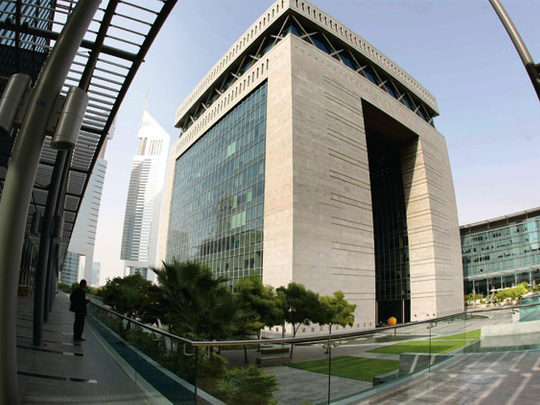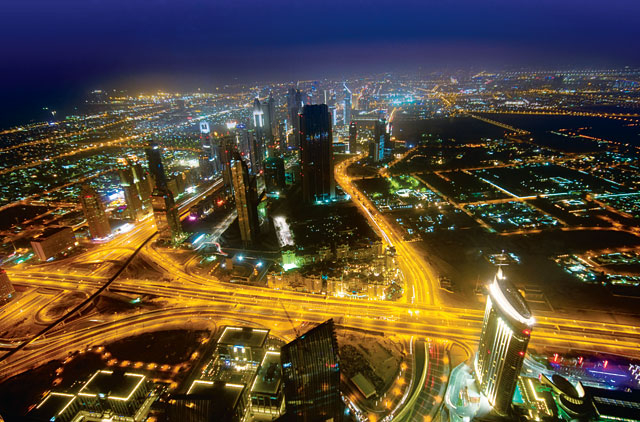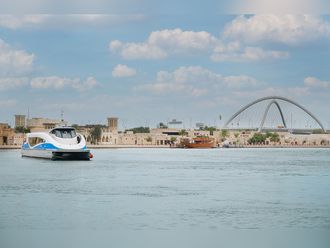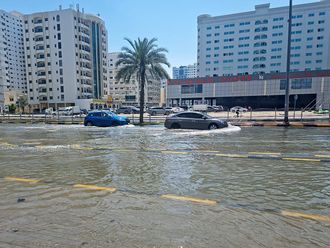
The stamps and postcards carrying the pale, halftone, sepia-colour image of Dubai's Clock Tower might be a thing of the past. But not so distant past as the faded image implies.
Constructed in 1964, the Clock Tower in Deira near Al Maktoum Bridge was the main landmark of Dubai in the 1960s and early 1970s. Dubai was still a small trading post — where goods used to be carried by wooden boats that provided the lifeline to the sleepy town's economy.
Not much is known of the ‘collection of the fishing settlements' that came to be called the Trucial States — the predecessors to the UAE — beyond the 1920s. However, the people of these settlements possessed a rich heritage and culture that were hundreds of years old, which bind them together even in this high-tech era.
In that light, the country might be 40 years young, but hundreds of years old.
However, things took a turn for the better when the leaders of the then Trucial States joined hands in 1971 to work together to build a common future with a shared vision.
On December 2, 1971, they embarked on a mission that saw the development of a vibrant economy that transformed parts of the barren ‘sandscapes' into planned cityscapes.
Suddenly, things began to change, and change very fast.
From the Clock Tower in Deira and the World Trade Centre Tower to Burj Khalifa, the tallest man-made structure in the world at 828 metres, the UAE has come a long way in 40 years. Looking back, it seems as if someone has fast-forwarded the country's future and completed a huge chapter in just 40 years. A hundred year's development appears to have been squeezed into four decades.
Forty years is a short period in a country's history. Most nations spend a few of their formative decades with growing pains — debating growth paths, engaging in conflicting ideas and mismanagement that result in loss of lives and wealth — among other man-made disasters.
However, the people of the UAE have been very fortunate. They did not have to undergo any such issues, although it wasn't a fairy-tale journey, either.
Not so long ago, the people of the Trucial States used to live on fishing, pearl diving and trade activities. Life in the harsh climate was confined to mud houses with wind towers providing access to some fresh air, often hot and humid.
Changing course
In 40 years, the country was transformed from a collection of a few trading posts to one of the world's vibrant economies, currently ranked as the second-biggest Arab economy after Saudi Arabia.
"The UAE has been a major economic and social development success story, with high growth of per capita income and major improvements across all socio-economic indicators — life expectancy rose from 62.5 years to 76.5 years as a result of improving health conditions, better diet and nutrition; the country succeeded in providing higher education to both men and women and also better living conditions," says Dr Nasser Saidi, Chief Economist, Dubai International Financial Centre (DIFC).
"Successive generations of Emiratis are living longer and better. Importantly, the UAE has transformed itself from being highly dependent on oil and gas to being a well-diversified economy, with a burgeoning services sector and industry as well as higher value-adds in petrochemicals, tourism and financial services completing the picture of a balanced economy."
With a gross domestic product (GDP) currently crossing Dh1 trillion, UAE nationals are one of the world's wealthiest people, with per capita GDP crossing $50,000 (Dh183,655).
The Economist Intelligence Unit (EIU) forecasts that the UAE economy will rise by 15 per cent to Dh1.15 trillion by the end of this year as oil output and crude prices are expected to be higher than in 2010. It adds that stronger oil prices will also boost the UAE's trade surplus hitting a new peak of Dh157 billion on a further anticipated rise in oil output and prices.
In trade, the UAE ranks among the world's top 20 countries. In 2009, the UAE's total exports reached $175 billion, making it the nineteenth-biggest exporter in the world, while the country's $140 billion import bill made it the 24th-largest importer in the world.
When you consider the UAE's achievement, the time frame of 40 years is nothing.
Hamad Mubarak Bu Amim, Director-General, Dubai Chamber of Commerce and Industry, says, "The UAE's growth did not pass through the supposed stages of development experienced by other developed nations. High oil revenues have enabled it to speed up the process of saving and capital accumulation, followed by spending and investment."
Prior to the first exports of oil in 1962, the UAE economy was dominated by pearl production, fishing, agriculture and herding. Since the rise of oil prices in 1973, petroleum has dominated the economy, accounting for most of its export earnings and providing significant opportunities for investment in development.
Many countries have proven reserves of oil and gas. However, the UAE has made the best and the most creative use of oil proceeds. During the first oil boom of the 1970s, its leadership invested heavily in physical infrastructure — building roads and highways, ports and airports, utilities and basic telecommunication systems — as well as human development that helped the nation to grow for the next 25 years. By then, the oil price collapsed and reached its lowest point.
The UAE has huge proven oil reserves, estimated at 97.8 billion barrels this year, with gas reserves estimated at 214.2 trillion cubic feet; at present production rates, these supplies would last well over 150 years. In 2009, the UAE produced about 2.41 million barrels of oil per day.
When oil prices began to increase in 2001-02, the UAE government was quick to identify the needs of the future. By then the infrastructure of the 1970s began to feel inadequate. In order to facilitate the next level of growth, the governments began to invest heavily in expanding infrastructure and communication that paved the way for further growth.
Sustainable development
Dr Justin Dargin, a research associate with the Dubai Initiative, a joint venture between the Dubai School of Government and the Harvard Kennedy School, and a Fulbright scholar, commented in a recent lecture how the UAE can use its prodigious energy resources to develop economically in a sustainable way.
"The issue of natural gas is essential to the economic development of [the UAE and] the Gulf. The region is blessed with abundant natural gas reserves, approximately 25 per cent of the global total, but the region has only about 8 per cent of the global production reserves.
"However, it was the sharp increase of the international price of oil and natural gas from 2001-08 that truly caused economic growth in the region to take off."
The investment in infrastructure between 2001 and 2009 has laid the foundation for growth for the next 25-30 years. Again, a classic example of utilising oil proceeds smartly before the oil price began to decline in 2009-10.
Dr Saidi says, "Importantly, the UAE's major investment in infrastructure have enabled it to become highly networked and internationally linked with advanced economies in the West and increasingly to the dynamic emerging economies of the East — notably India and China — and Africa.
"The UAE is today the most modern economy of the Arab world, its business and financial hub, and increasingly its main tourist hub."
Foreigners look at the UAE's phenomenal economic growth and prowess that raised its profile among the international community with awe. Inevitably the question arises. How has the country achieved such growth in such a short time? What are the factors that contributed to this? The answers are quite simple.
The UAE's strategic geographic location, firm leadership that understands the country's potential with a vision to fulfil it, and wise use of oil revenues are some of the key reasons for its success.
Bu Amim says, "The UAE's strategic location has contributed to its exceptional growth. Located between the East and the West, the UAE is in the centre of the map with easy access to the Middle Eastern, European, Asian and African markets. Because of this, Dubai has always been a major trading post, and with its modern facilities and infrastructure it will continue to be so."
The government also invested in its people to develop a disciplined human talent base that provided the solid foundation for its economic growth.
Dr Saidi says, "Economic success would not have been achieved with [just] good governance and leadership. Leadership has provided a vision for the UAE economy and society, of developing the country into an open and tolerant society, be it at a multicultural level or at the level of religious harmony. The vision of the UAE [leaders] has enabled the country to become a ‘Nation of Builders'.
However, the country's phenomenal growth did not come without any challenges. In fact, its road to success was full of obstacles. During the past 40 years, the country faced repercussions of the Iran-Iraq War, two Gulf Wars, September 11, the war on Iraq, economic sanctions against Iraq and Iran and, last but not the least, the Arab Spring that is reshaping the region's political landscape.
However, during each of these challenges, its wise leadership has managed to steer the country out of the crisis and, in some cases formulated policies that actually helped the country to benefit in some ways from them. For example, sanctions against Iran helped its traders to develop business.
Wide connectivity through land, air and sea has meant accelerated growth in trade, tourism and retail sectors. Because of this, the country with a population of about eight million has five airlines that cater to a growing number of visitors that include tourists and traders. Together, they provide a formidable winning combination.













